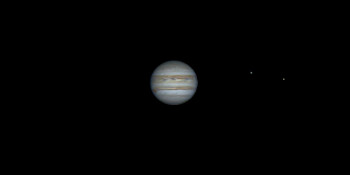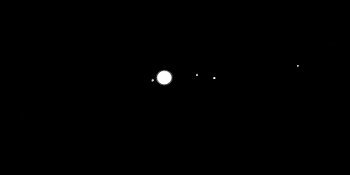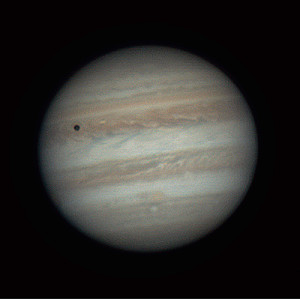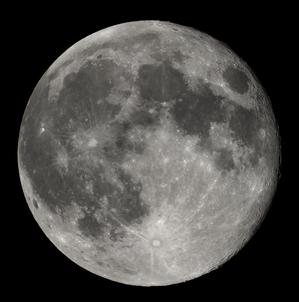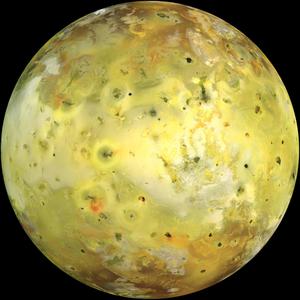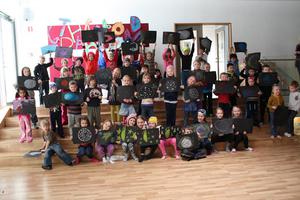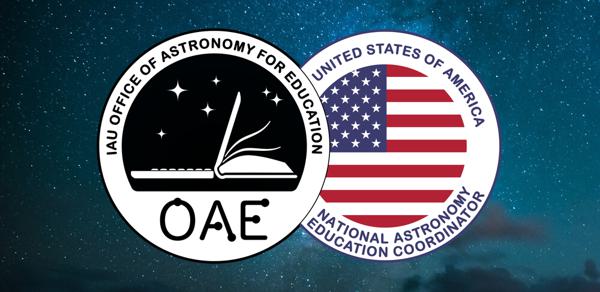Glossary term: Lunes
Description: Les lunes sont des corps célestes en orbite autour de planètes, de planètes naines ou d'objets plus petits tels que les astéroïdes. La Terre possède une lune, appelée la Lune. La plupart des autres planètes du système solaire ont des lunes, à l'exception de Mercure et de Vénus. La planète naine Pluton possède plusieurs lunes, tout comme un petit nombre d'autres planètes naines et d'astéroïdes. Les lunes sont des satellites naturels ; les satellites artificiels, tels que ceux utilisés pour les communications ou à des fins scientifiques, ne sont pas des lunes.
De nombreuses lunes se sont formées en orbite autour de la planète, de la planète naine ou d'un autre corps qu'elles orbitent. On pense que la Lune s'est formée en orbite autour de la Terre à partir de matériaux éjectés lors d'une collision majeure entre la Terre et un planétoïde à un stade précoce de la formation du système solaire. De nombreuses autres lunes (pour la plupart plus petites) sont des astéroïdes qui ont été capturés par la gravité de l'objet autour duquel ils gravitent.
Related Terms:
See this term in other languages
Term and definition status: The original definition of this term in English have been approved by a research astronomer and a teacher The translation of this term and its definition is still awaiting approval
The OAE Multilingual Glossary is a project of the IAU Office of Astronomy for Education (OAE) in collaboration with the IAU Office of Astronomy Outreach (OAO). The terms and definitions were chosen, written and reviewed by a collective effort from the OAE, the OAE Centers and Nodes, the OAE National Astronomy Education Coordinators (NAECs) and other volunteers. You can find a full list of credits here. All glossary terms and their definitions are released under a Creative Commons CC BY-4.0 license and should be credited to "IAU OAE".
If you notice a factual or translation error in this glossary term or definition then please get in touch.
Related Media
Jupiter's Rotation, by Vishal Sharma, India
Credit: Vishal Sharma/IAU OAE
License: CC-BY-4.0 Creative Commons Attribution 4.0 International (CC BY 4.0) icons
Jupiter Moons Movie2, by Nicolas Hurez, Paul-Antoine Matrangolo, and Carl Pennypacker, United States of America
Credit: Nicolas Hurez, Paul-Antoine Matrangolo and Carl Pennypacker/IAU OAE
License: CC-BY-4.0 Creative Commons Attribution 4.0 International (CC BY 4.0) icons
Jupiter, Io and its shadow, by Ralf Burkart, Germany
Credit: Ralf Burkart/IAU OAE
License: CC-BY-4.0 Creative Commons Attribution 4.0 International (CC BY 4.0) icons
Pleine lune
Credit: Luc Viatour credit link
License: CC-BY-SA-3.0 Creative Commons Attribution - Partage dans les Mêmes Conditions 3.0 non transposé icons
Io
Credit: NASA/JPL/Université d'Arizona credit link
License: PD Public Domain icons
Related Activities
Deadly Moons
astroEDU educational activity (links to astroEDU website) Description: Through art and science, children learn about moons of our solar system.
License: CC-BY-4.0 Creative Commons Attribution 4.0 International (CC BY 4.0) icons
Tags:
Art
, Creativity
, Hands-on
, Drawing
Age Ranges:
6-8
, 8-10
, 10-12
Education Level:
Primary
, Secondary
Areas of Learning:
Fine Art focussed
, Social Research
Costs:
High Cost
Duration:
1 hour
Group Size:
Group
Skills:
Asking questions
, Communicating information
